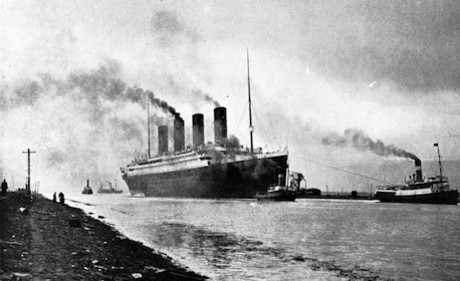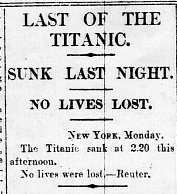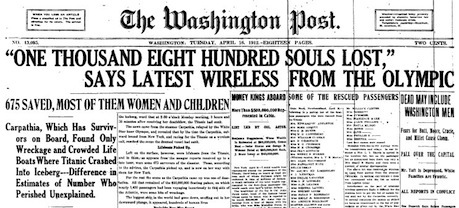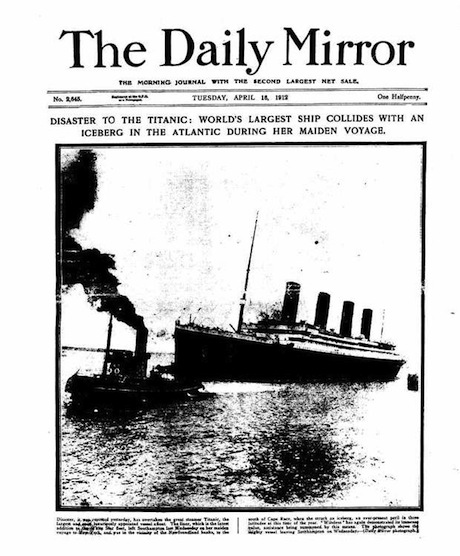
RMS Titanic undergoing sea trials before her fateful voyage
Credit: Image from U.S. NARA via Wikimedia CommonsThe Titanic was one of the biggest stories of the last century, and has since captured the imagination of generations through the written word and both the big and small screen. But in a time long before Twitter and search engine optimisation, journalists in smoky newsrooms on both sides of the Atlantic scrambled to make sense of a situation no one had anticipated.
Christopher Sullivan is an editor on the features desk at Associated Press in New York and has spent the last couple of weeks looking at how the story was reported.
"No lives lost." That is what the Daily Mail’s front page said on 16 April 1912 – a mistake that was not entirely its fault, according to Sullivan.
 He told
Journalism.co.uk: "In the course of the wireless chatter someone
asked the question: 'Are the Titanic passengers safe?' … Shortly
after came back the answer: 'The ship is being towed to Halifax and
everyone is ok'. That second transmission was accurate, except it
didn’t refer to the Titanic."
He told
Journalism.co.uk: "In the course of the wireless chatter someone
asked the question: 'Are the Titanic passengers safe?' … Shortly
after came back the answer: 'The ship is being towed to Halifax and
everyone is ok'. That second transmission was accurate, except it
didn’t refer to the Titanic."He said the methods journalists used to try to verify the "unbelievable report" that the 'unsinkable' ship was sinking have not changed over the past 100 years.
"It was a sleepy news night until the first word [of the sinking] came in … when this came through the first [thing to do] was to call the folks along the Canadian coast who were reporting this to try to get any more detail that they had.
"There were then calls to the shipping line to get whatever their take on the story was."
“It was a sleepy news night until the first word came in"Christopher Sullivan
Sullivan added: "Some of the media historians I talked to about this compared it to some of the early reports of 11 September. At the very beginning, when the story is just developing, there's so much confusion and everyone is doing everything they possibly can to grab any piece of information."
Sullivan's journey started in the archives of the Associated Press, although the records were not as complete as he had hoped.
"The actual wire copy that appeared as the story was unfolding [was not there], but among what was were a lot of archived descriptions of that night."
"It was a huge story … the AP like everyone else rented the whole floor of a hotel and sent just about every possible reporter down to the docks where there were thousands of people waiting."

Newspapers in America appeared to use their advantage of an extra six hours before publication, because of the time difference, to put together a clearer picture of what happened than their British counterparts.
On the same day that the Daily Mail claimed "No lives lost", the New York American newspaper went with "1,500 to 1,800 dead", and presented an amazing artist's impression of the moment the ship hit the iceberg underneath.
The New York Times' front page included the more conservative "probably 1,250 perish" but also provided a partial list of the survivors. The Washington Post printed "One thousand eight hundred souls lost", a quote taken from a radio transmission from the Titanic's sister ship Olympic.

However, the British dailies gave it their best shot. The Daily Mirror devoted most of their front page to a picture of the ship as she left Southampton, with the headline "Disaster to the Titanic", while the precursor to the Evening Standard, the London Evening News, ran the headline "Titanic disaster: Great loss of life", providing the content for the iconic photo of a boy selling copies of the newspaper outside the White Star Line's offices.
Sullivan says while the story is not remembered for its reporting, the legacy of the mistakes that were made lives on.
"We know about the mistakes of that time and we know how large scale they were that surely we all have this in the back of our minds when we're reporting big stories … Lets not do that again."
Free daily newsletter
If you like our news and feature articles, you can sign up to receive our free daily (Mon-Fri) email newsletter (mobile friendly).
Related articles
- Fact-based journalism more vital than ever for 2020 US election
- Need a source for your next story? This platform puts experts on speed dial
- Associated Press launches multimedia series exploring citizen responses to climate change
- How can news organisations hire diverse talent to grow audiences?
- Newsrooms must learn how to use AI: "Trust in journalism is at stake"









